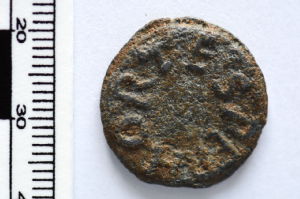All 1 entries tagged Bnf
No other Warwick Blogs use the tag Bnf on entries | View entries tagged Bnf at Technorati | There are no images tagged Bnf on this blog
October 01, 2019
Hortensia Sperata, Token Issuer in Rome or Ostia
 |
 |
Lead token from Rome or Ostia, now in the The Bibliothèque nationale de France in Paris (Rostowzew and Prou 422a). 12h, 20mm, 4.13g, TURS 1241.
Side A: HORTE SPER around in a circle.
Side B: Palm branch within a wreath.
Pictured above is a lead token, which, from the style of its design and its fabric, we can assign either to the city of Rome or to Ostia. What is remarkable about this piece is that the token carries the name of a Roman woman: Horte(nsia) Sper(ata). Her name circles around the edge of one side of the token in a way very similar to Roman coinage. The other side carries imagery commonly found on lead tokens in this region: a wreath and palm branch. These communicate to the user a festive, happy atmosphere.
This was not the only token that Hortensia issued. Another token carries her name in full: HORTENSIA SPERATA, with the same design (palm branch within wreath) on the other (TURS 1240). Two further tokens are smaller in diameter (13-15mm) and seem to carry an abbreviation of her name: HOR on one side and SPE or SP on the other (TURS 1242, 1243). Why would Hortensia have so many variant tokens? She might have wished to have two sizes of token (20mm and 13-15mm), with one perhaps worth more than the other, or with each representing different products or levels of access. An engraver could have created a mould for her tokens that cast both sizes at once, a practice known from other surviving examples.
 |
The palombino marble mould pictured here would have been utilised to make tokens during the Roman imperial period. It was found along with several others on the Esquiline Hill in Rome in 1882. Here we can find another individual responsible for tokens, whose name has been abbreviated to LVE (a practice also commonly found in graffiti). Like the tokens of Hortensia, we can see that LVE wanted two sizes of token: a larger and a smaller piece. On the smaller piece his initials have become ligate: i.e. they have been joined together ti fit into the reduced size. In a similar way Hortensia's name was abbreviated on her smaller tokens.
We do not know anything more about Hortensia Sperata, but one presumes she had a certain amount of wealth. From the men and women named on Roman lead tokens, some were magistrates in government or colleges; others appear to be linked to bath houses. Whatever the specific use of these tokens (and it is very hard to be certain), they were likely used in an act of patronage: the provision of necessary small change, for example, the sponsoring of a banquet or other event, or a distribution. The lead tokens of Rome and Ostia reveal a world otherwise unrecorded in our sources, where both men and women utilised these objects to cement personal relationships and consolidate local communities.
This coin of the month blog was written by Clare Rowan as part of the ERC-funded Token Communities in the Ancient Mediterranean Project.
 Clare Rowan
Clare Rowan

 Please wait - comments are loading
Please wait - comments are loading

 Loading…
Loading…

